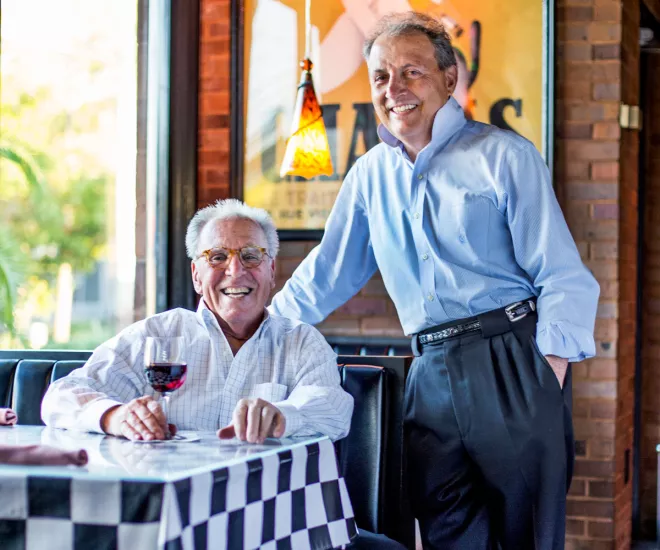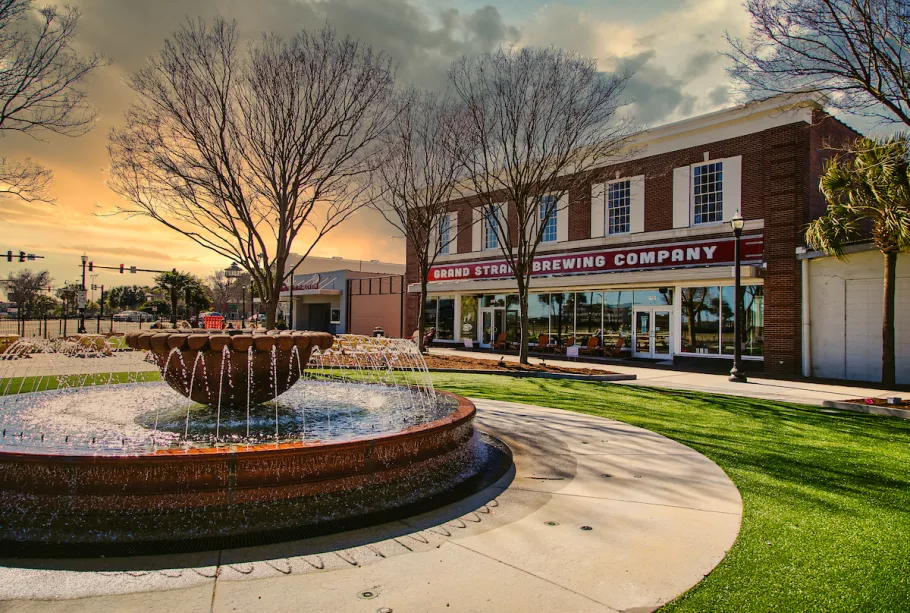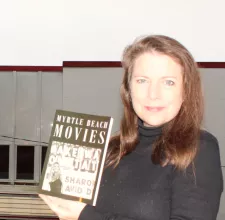Iconic Restauranteur Dino Thompson on Growing Up in Myrtle Beach Restaurants

Few locals have a biography more intertwined with Myrtle Beach’s history than Dino Thompson. When he was a baby, his parents were just passing through on their way to start a new life in Florida after WWII when they stopped at a local diner, the Kozy Korner, for lunch.
The proprietor struck up a conversation and soon discovered that their aspiration was to own such a diner in the Sunshine State. Seizing the opportunity, the café owner revealed that it just so happened that his establishment was available and that the Thompsons could take over the lease for the space and an apartment upstairs.
Before the end of the day, Dino’s dad was introducing himself to the staff as the new owner. It would be the first of nine Myrtle Beach restaurants he would own throughout the subsequent decades and Dino worked at all of them.
From his childhood bedroom in that upstairs apartment, Dino could survey his whole world: the beach two blocks away, the amusement park across the street, and the stores and movie theater on his block. Myrtle Beach was a relatively small resort town in the late 1940s, but it was even smaller for Dino. Not until he was in kindergarten did he meet the “North End Kids” who lived in the neighborhoods of Pine Lakes and the Dunes Club.
He was a “South End Boy” through and through. In the season, he was at the Pavilion every night. It was our open air, ocean front, amusement venue complete with concession stands, arcade games and a jukebox on the dancefloor.
During those precious few months when the tourist dollars flowed in, the South End Boys worked to earn their share of that income. Dino says that, if you were three and half feet tall, you had a summer job. Whether it was carrying luggage, serving foot long hotdogs, or holding the coveted position as a beach monkey-- a lifeguard’s assistant—South End Boys worked hard for the money. And since most tourist-related businesses were mom & pop’s there was no minimum age requirement to work for your family. I’m a generation younger than Dino, and I was cashing my first paychecks at about nine years old cleaning kennels and helping clients at my dad’s veterinary hospital.
When Dino was ten, he was the night manager at the Kozy Korner while his parents, Tony and Angie, ran their other restaurant, the upscale Black Angus steakhouse. Granted, the trusted kitchen and wait staff at the Kozy Korner were adept at their tasks, but Dino ran the register and made sure the doors were locked and the lights were off at the end of the night.
The Kozy Korner has long since been closed, but if you would like to eat at that location, you may. Winna’s Kitchen fills the triangular tip of that historic building. It is adjacent to Nance Plaza which is in the heart of Myrtle Beach’s new historic district. That plaza is the home of another great eatery (and microbrewery), Grand Strand Brewing Company.

But if you want to meet our local legend, you’ll find Dino at his current restaurant, Flamingo Grill. While there, pick up copies of his three books, Greek Boy, Boogie Woogie Beats, and his just released tome, Cluster Forks. The first is a detailed account of what it was like to grow up in Myrtle Beach in the mid twentieth century. The second gives an overview of the music he grew up with. And the third tells of the crazy antics he has experienced in the restaurant business here.
His earlier restaurant, Cagney’s, was one of Myrtle Beach’s most well-known. Like Flamingo, it had an excellent reputation for its cuisine and service. What made it particularly special was the décor. Dino had spent years collecting antiques and other interesting items to showcase in the multiple dining areas. The most prized accessories were those he got from the historic Ocean Forest Hotel before it was razed on Friday the 13th, in September of 1974. In fact, some of the rubble from the demolition was buried on the lot where Cagney’s was built. When Dino was younger, he had earned extra money by working at the Ocean Forest as a bellhop in the off season, when his dad didn’t need him as much at the restaurant.
Often, Dino, as a child, would accompany his father when he would take the kitchen staff home. Most of them lived in the historically African American district that was called “The Hill,” now known as the Booker T. Washington Neighborhood. While on Carver Street, Tony would take the opportunity to drop in at Charlie’s Place and have a drink with the owner, his friend, Charlie Fitzgerald. Dino would play the pinball machine at the popular club while they talked. Even though it was during segregation, Charlie welcomed everyone to his establishment.
When Dino was a teenager, he would take his friends there to dance and there was never any trouble. Charlie and his wife, Sarah, had watched Dino grow up and kept a watchful eye on him when he was at their club. Once, when Dino was still a boy, some guys who worked in the Kozy Korner kitchen took Dino to Charlie’s Place to see Little Richard perform right at the time when the rock ‘n roll legend had his first hit. Dino was placed on the end of the stage for an unforgettable concert.
Dino now serves on the Charlie’s Place Historic Site advisory board that has worked diligently to preserve the Fitzgeralds’ home and create a replica of their motel units. When you go inside the house, you will see posters designed to share some of the history of the musical acts who once performed at the club that is no longer there. Dino created those, had them framed and donated them for visitors to enjoy. I hope that the club itself will be replicated one day.
Not too long ago when we were both at Charlie’s Place for a meeting, Dino told me a story that gets me choked up when I think about it and made him a little teary-eyed when he shared it. There was an African American gentleman who was a friend of his who had grown up across the street from Charlie’s Place. I had not met him before he passed away, but his daughter was a year ahead of me in school and we had had a dance class together when I was in sixth grade.
Once, when Dino's friend was a kid during segregation and not too long after the Thompson family came to town, a boy from the neighborhood came running down Carver Street yelling to everyone who could hear him that he had seen the most incredible thing. With much excitement, Dino’s friend and all of the other children quickly followed the boy back to where he had witnessed the spectacle.
At a full sprint, it would have taken them five to ten minutes to arrive downtown near what was then Chapin Company, the department store. From their vantage point across the street, they could see into the plate glass window of the Kozy Korner. The smaller children had to be lifted up to see above the writing on the window. But they were all amazed at what they saw. Charlie Fitzgerald, a Black man, was eating in a White establishment. Those children did not know that that was a possibility. His friend told Dino that that was a life changing moment for them all.
